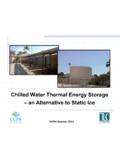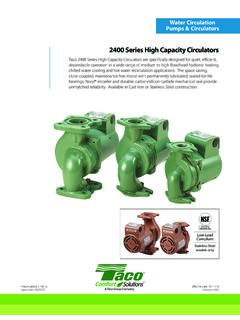Transcription of Optimized Chilled Water Plant Controls 2013-11-12-1
1 Optimizing Chilled Water Plant Design & ControlsSteven T. Taylor, PETaylor EngineeringAlameda, CANovember 12, 20132 Agenda Chilled Water Distribution system Selection Determining Optimized Sequences Chilled Water Pump Control Chilled Water Temperature and DP Setpoint Reset Tower Fan Speed Control Condenser Water Pump Control Chiller Staging Waterside Economizer Control3 Primary Resources Optimized Design & Control of Chilled Water plants , ASHRAE Journal Part 1: Chilled Water Distribution system Selection Part 2: Condenser Water Distribution system Design Part 3.
2 Pipe Sizing and Optimizing T Part 4: Chiller & Cooling Tower Selection Part 5: Optimized Control Sequences All are available at no charge from Energy Usage Chillers Type, efficiency, size, VSD Cooling Towers Fan type, efficiency, approach, range, speed control, flow turndown Chilled Water Pumps Arrangement, flow rate (delta-T), pressure drop, VSD Condenser Water Pumps Flow rate (delta-T), pressure drop Air Handling Units Coil sizing, air-side pressure drop, Water -side pressure drop5 RecommendedChilled Water Distribution ArrangementIndependent VariablesRecommended SystemNumber of Coils/Loads ServedNumber of ChillersSize of Coils/Loads ServedControl Va l v e sDistribution TypeOneAnyAnyNonePrimary-only single coilMore than oneOneSmall (< ~100 gpm)2-way and 3-wayPrimary-only, single chillerFew coils serving similar loadsMore than oneSmall (< ~100 gpm)
3 3-wayPrimary-only constant flow Many coils serving similar loads or any serving dissimilar loadsMore than oneSmall (< ~100 gpm)2-wayPrimary-Only orPrimary-SecondaryMore than oneAnyLarge Campus2-wayPrimary Distributed SecondaryMore than oneAnyLarge coils (> ~100 gpm)NonePrimary Coil Secondary 6 CHILLERCHW PUMPOPTIONAL STORAGE TANKCOILSUPPLY AIR TEMPERATURESUPPLY Water TEMPERATURES ingle Coil Single Chiller7 CHILLERCHW PUMPCOIL2-WAY VALVESUPPLY Water TEMPERATUREVFDDP SENSOR3-WAY VALVEP rimary-only - Single chiller3-Way Valve Sized for minimum flow of chiller Locate at end of system Engage mass Retain self-balancing8 Primary-only Constant Flow 9 Secondary Pump w/ VFD at Chiller Plant2-Way Control Valves at AHUsSecondary Pump w/ VFD at Chiller Plant2-Way
4 Control Valves at AHUsPrimary/Secondary10 Primary/Distributed SecondaryCentral PlantDistributed Secondary Pump w/ VFD -Typical at each BuildingNo Secondary Pumps at Plant11 Distributed P/S versus Conventional P/S or P/S/T Advantages Reduced Pump HP - Each Pump Sized for Head From Building to Plant Self-balancing No Over-pressurized Valves at Buildings Near Plant Reduced Pump Energy, Particularly When One or More Buildings Are off Line No Expensive, Complex Bridge Connections Used in P/S/T Systems Similar or Lower First Costs Disadvantages (vs.)
5 P/S) Pump room needed at building Higher expansion tank pre-charge and size 12 Primary/Coil SecondaryLarge AHU-1 Distributed Secondary Pump w/ VFD -Typical at each AHUNo Secondary Pumps at PlantLarge AHU-2No Control Valves at AHUs13 Hybrid systems14 Advantages of VFD Coil Pumps versus Conventional P/S system Reduced Pump HP Each pump sized for head from coil to Plant Eliminated 10 feet or so for control valves Self-balancing No need for or advantages to balancing valves, reverse return Lower Pump Energy No minimum DP setpoint Pump efficiency constant Better Control Smoother flow control - no valve hysteresis No valve over-pressurization problems Usually Lower First Costs Due to Eliminated Control Valves, Reduced Pump and VFD HP15 Disadvantages of VFD Coil Pumps versus conventional P/S system Cannot Tap into Distribution system without Pump May be problem with small coils (low flow, high head pump)
6 Possible Reduced Redundancy/Reliability unless Duplex Coil Pumps are Added Possible Low Load Temperature Fluctuations Minimum speed on pump motor May need to cycle pump at very low loads16 Primary-only SystemBYPASS VALVEH eadered Pumps & Auto Isolation Valves Preferred to Dedicated Pumps: Allows slow staging Allows 1 pump/2 chiller operation Allows 2 pump/1 chiller operation if there is low TFlow Meter or DP Sensor Across Chiller17 Advantages of primary-only versus primary/secondary system Lower First Costs Less Plant Space Required Reduced Pump HP Reduced pressure drop due to fewer pump connections, less piping Higher efficiency pumps (unless more expensive reduced speed pumps used on primary side)
7 Lower Pump Energy Reduced connected HP Cube Law savings due to VFD and variable flow through both primary and secondary circuit18 Pump EnergyPrimary vs. Primary/Secondary (3-chiller Plant ) 20% 30% 40% 50% 60% 70% 80% 90% 100%% GPMPump kWPrimary-onlyPrimary-secondary19 Disadvantages of primary-only versus primary/secondary system Failure of Bypass Control Not as fail-safe - what if valve or Controls fail? Must avoid abrupt flow shut-off ( valves interlocked with AHUs all timed to stop at same time) Must be well tuned to avoid chiller short-cycling Flow Fluctuation when Staging Chillers On Flow drops through operating chillers Possible chiller trips, even evaporator freeze-up Must first reduce demand on operating chillers and/or slowly increase flow through starting chiller.
8 Causes temporary high CHWS temperatures (Problems above are seldom an issue with very large plants , more than 3 chillers)20 Primary-only system Staging1000 GPM0 GPM0 GPM21 Primary-only system Staging500 GPM500 GPM0 GPM22 Variable FlowPrimary/Secondary with CHW Storage Advantages Peak shaving Simplifies chiller staging Provides back-up for chiller failure Secondary Water source for fire department Secondary Water source for cooling towers Disadvantages Installed cost Space23 Primary-only vs. Primary/Secondary Use Primary-only Systems for: plants with many chillers (more than three) and with fairly high base loads where the need for bypass is minimal or nil and flow fluctuations during staging are small due to the large number of chillers; and plants where design engineers and future on-site operators understand the complexity of the Controls and the need to maintain them.
9 Otherwise Use Primary-secondary Also for plants with CHW storageOptimizing Control SequencesGeneric Chilled Water Plant 1000 Tons total capacity Dual chillers/pumps/towers Variable speed drives on everything (optional on CWPs)26 Optimum Sequences All plants are different Tower efficiency, approach Chiller efficiency, unloading control Pump efficiency, head, unloading control Number of chillers, pumps, towers Too many independent variables CT fan speed Chiller staging CW pump speed What is the optimum control sequence for a given Plant ?
10 Can sequences be generalized to apply to any Plant based on Plant design parameters?27 Equipment Models Chillers Hydeman et al, Regression Based Electric Chiller Model Multi-point calibration using zero-tolerance manufacturer s data Towers model calibrated using manufacturer s data Pumps Multiple piping sections P=C* Pump efficiency from regression of manufacturer s data VFD and motor efficiency Part load curves from manufacturer s data28 Generic Plant Design Options Plant Office building Peak Load = 900 ton Two chillers each 500 ton Two CW pumps & towers Two CHW pumps All variable speed Climate: 3C: Oakland 4B.






